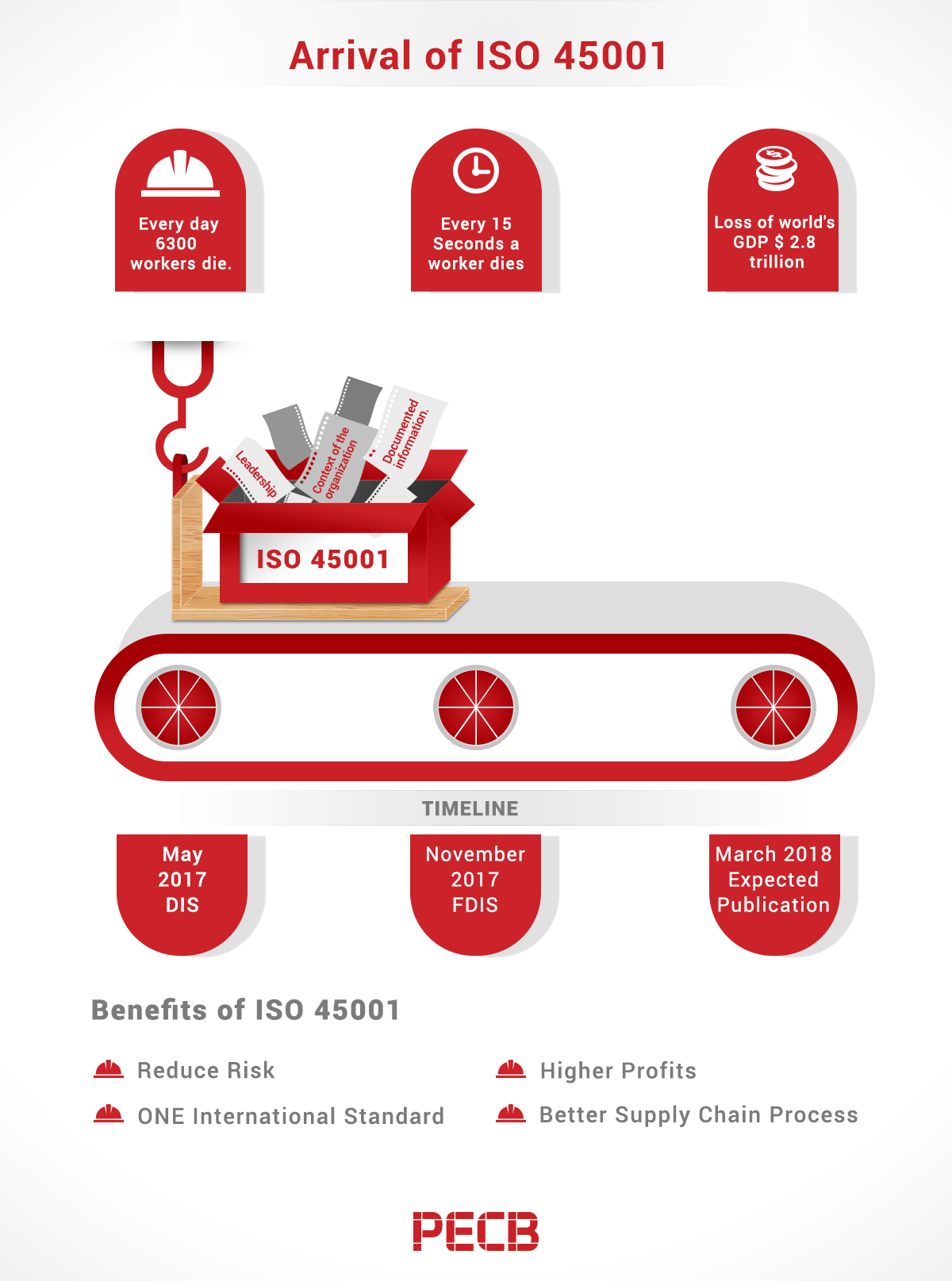A shocking statistic of work-related accidents or diseases that occur daily is recorded worldwide.
According to ILO, every day 6,300 workers die as a result of unfortunate events in the workspace or as a result of work-related diseases, meaning, one worker loses his life every 15 seconds. In 2014, this added up to 2.34 million, a figure that has raised awareness for the need of a new set of occupational health and safety regulations and requirements.
The measurable loss of world’s GDP due to accidents and diseases is 4 %, which is equivalent to about $ 2.8 trillion. The existing British standard, OHSAS 18001, helps organizations to implement a framework and guidelines for the control and identification of risk, accidents, and the organizations’ overall OHS performance. It helps companies to control and/or mitigate risk issues and problems that may arise. At present, there are about 90,000 companies with OH&S certification, in more than 127 countries.
Nevertheless, in the past twenty years, the idea of a new International Globalized Standard has been presented. After a few attempts, more than 60 countries have come together to create a global document that will provide a framework for the improvement of OH&S. This document is the new ISO 45001 Occupational Health and Safety management systems requirements that will replace OHSAS 18001. ISO 45001 is applicable to any organization, regardless of size or the nature of the work. The objective of ISO 45001 has retained that of OHSAS 18001, but with some changes in the standard’s requirements, in order to meet the needs of today’s business model and to mesh with other recently revised standards.
The main changes are:
The ISO 45001 incorporates Annex SL Framework – the management system format that helps with the creation of Standards and its implementation in organizations. In the future, it is estimated that Annex SL will represent 30-40 % of ISO system standards. The Annex SL Framework includes 10 Chapters, some of which are already familiar to the public and users of the standards. High-level structure clauses:
- Scope
- Normative references
- Terms and definitions
- Context of the organization
- Leadership
- Planning
- Support
- Operation
- Performance evaluation
- Improvement
New concepts are included in individual clauses:
- Context of the organization,
- Leadership,
- Documented information.
The context of the organization – Requires a detailed approach in the evaluation of internal and external factors that impact your company. Modification of labor relations, new technology, new materials and services coming from outside might present a risk. ISO 45001 requires you to take into consideration all of the mentioned factors, evaluate them, and decide what measures need to be taken in order to avoid or mitigate risks.
Leadership – There is a strong focus on the top management and leadership. This means that everyone must be included in the decision making process, not only the senior leaders but all levels of the organization.
Documented Information – A new concept that supports the modern world of processed data, which still incorporates the need for documentation and records.
Terms and Definitions The terms and definitions section has also been modified in order to make the standard more suitable for any organization regardless the size. ‘Hazard Identification’ is likely to be replaced by the terms ‘Risk Identification’ and ‘Risk Control’. It has been identified that the term ‘Hazard Identification’ is rarely used in isolation and forms only a single level of the overall risk process. Preventive action has been removed. As the focus of the management system and its purpose is to control risks, it is considered that a properly implemented management system will become the key preventive tool.
Benefits of the new Standard:
1. Reduce Risk
ISO 45001 has a greater focus on increasing the awareness of occupational health and safety risk. It will provide a framework for organizations of any size and function for the protection of their workers and will provide them with a better system of occupational health and safety. This framework guides and helps a company to correct or mitigate any issues regarding their plant, equipment, facilities and workplace environment. By fully implementing the standard, a company will see a decrease in the number of incidents and accidents in the workplace and will avoid the possible threat of a costly lawsuit or another statutory penalty.
2. Higher Profits
By incorporating ISO 45001 into the operating system of the company that meets other standards, such as ISO 9001 and ISO 14001, and fully implementing it, the organization will see a reduction in lost and non-productive time as a result of accident and incident. This will lead to the organization developing a safer work environment and greater productivity, with higher employee retention, which will then lead to higher profits.
3. A single internationally agreed standard
There is a question spread throughout the user’s community: why do we need a new standard when the current one is successful? Nowadays, many organizations are already using ISO management systems standards, so having a matching ISO occupational health and safety system standard makes it easier to integrate it with other systems. It is recognized that existing British standard OHSAS 18001 helps organizations to implement a framework and guidelines regarding the control and identification of risk, accidents, and overall performance, and the new standard has its base in this. In addition, ISO has also become a benchmark for companies wanting to link their name with success and thus linking OHS to ISO makes good sense.
4. Supply chain and contractor/sub-contractor quality process
There are often many health and safety challenges encountered with goods or services provided by an external supplier, contractor or sub-contractor. By implementing the standard, an organization can then set measures, objectives, and targets for their service providers. They can require that their vendors establish and implement a health and safety management system in line with the standards. This will then lead to a significant improvement in the overall supply chain process.
ISO 45001 is currently under development and subject to acceptance is to be published by the end of 2016. The transition period from OHSAS 18001 to ISO 45001 is likely to last 2-3 years. For the existing users, it is important to get a draft of the standard, have a detailed look, and plan a transition process towards ISO 45001. For companies that are not using any of the two standards, a good starting point is to use OHSAS 18001 as a guide as to what is coming in 2016. PECB is a certification body for persons, management systems, and products on a wide range of international standards. As a global provider of training, examination, audit, and certification services, PECB offers its expertise in multiple fields, including OHSAS 18001, and soon ISO 45001 courses as well.
About the authors:
Suzana Ajeti is Trainer/ Auditor and Training Certification Program Manager. She is in charge of recruiting, evaluating and certifying professionals of ISO fields as PECB Trainers and PECB MS Auditors. If you have any questions, please do not hesitate to contact her: trainer@pecb.com.
Mike Gray is a highly qualified vocational education trainer, assessor and PECB Certified Trainer, delivering training in ISO 9001 Quality Management, ISO 14001 Environment, OHSAS 18001 Health and Safety, ISO 22000 Food Safety and ISO 31000 Risk Management. If you have any questions, please do not hesitate to contact him: mike.gray@mgtdpirii.edu.au.










